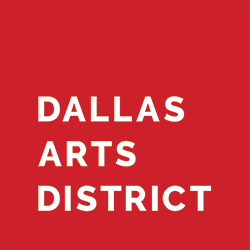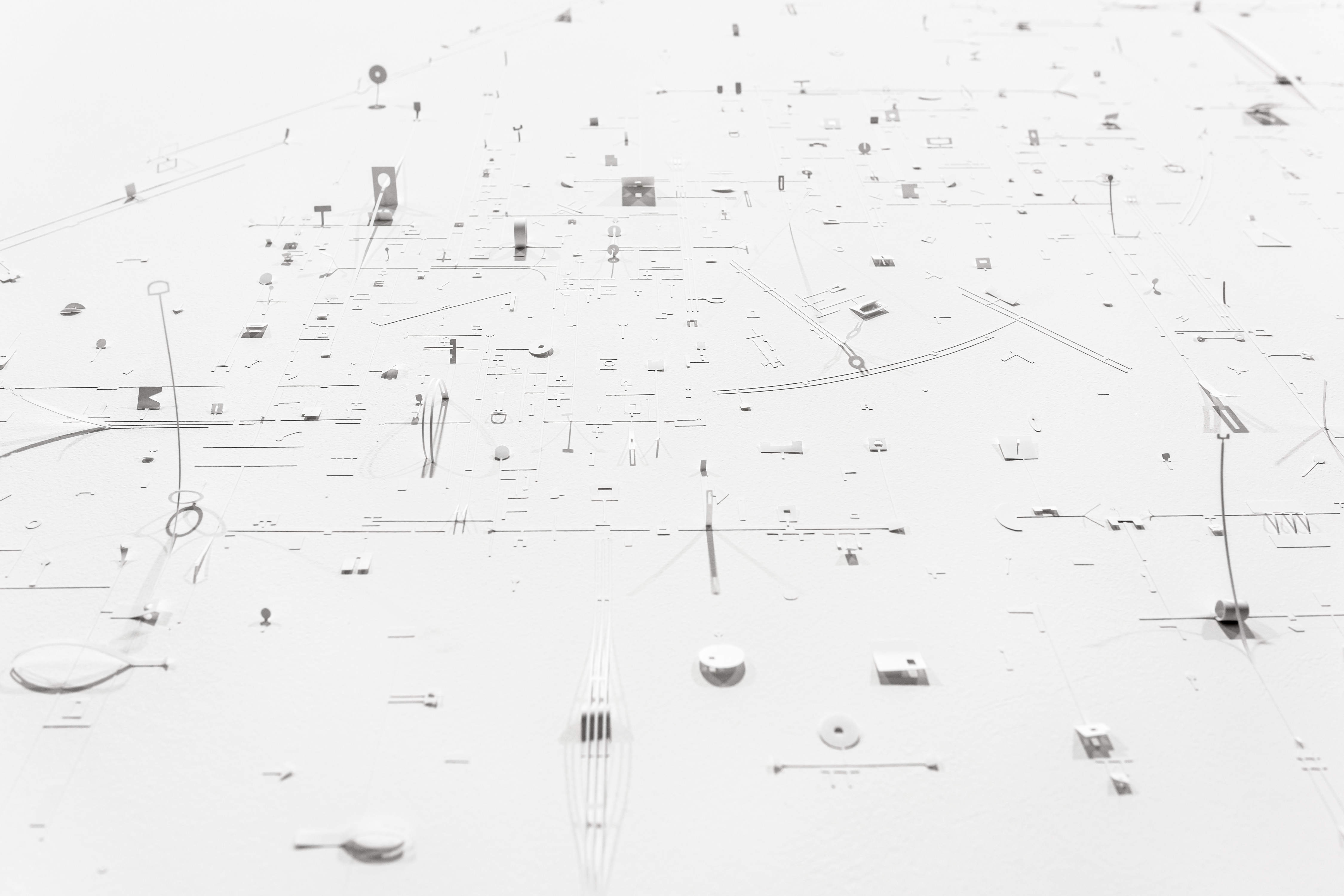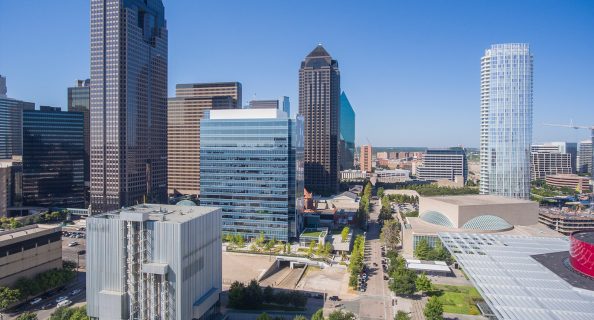Nasher Sculpture Center Announces Paper into Sculpture Exhibition
Considers paper as a dynamic sculptural medium
Two ancillary exhibitions—a collection of paper works related to Esopus magazine and the outsized book and Duchampian homage, Fountainhead—will also to be on view
DALLAS, Texas (August 3, 2017) – The Nasher Sculpture Center announces Paper into Sculpture, an exhibition highlighting the dynamic ways two-dimensional paper can be used to create three-dimensional objects and installations. Featured artists are: Noriko Ambe, Marco Maggi, Joshua Neustein, Nancy Rubins, and Franz West. The exhibition will be on view October 14, 2017 – February 4, 2018.
The artists in Paper into Sculpture play on tensions between commonly held understandings of sculpture and what paper can and cannot do, pushed to its physical limits. Treating paper as a material with a palpable three-dimensional presence rather than as a mere support for mark-making, they use processes ranging from cutting, crumpling, and tearing to scattering, binding, and adhering to create sculptural works that take a variety of forms, with a diverse range of expressive and conceptual implications.
Even as the shift to digitized images, virtual reality, and social media has been said to herald its obsolescence, paper nonetheless remains inescapable. Accessible to all, paper endures as the site of notes, lists, price tags, reminders, sketches, ads—at once the most mundane and the most intimate of communication media, and the most readily discarded. As concerns about humanity’s impact on the environment intensify, paper is also one of the most persistent reminders of our connections to nature through the cyclical nature of its creation, disposal, and regeneration through recycling. Derived largely from plant fibers, paper also ages and degrades, its fragility inspiring metaphorical associations with human corporeality and vulnerability.
“Paper into Sculpture is an exhibition that highlights the vast possibilities of sculpture, but also its often humble origins in the most quotidian of materials,” says Director Jeremy Strick. “The show promises to offer new insight into the myriad ways that artists approach a shared material, with divergent and insightful sculptural results.”
The exhibition is organized by Nasher Curator Catherine Craft.
Esopus
Concurrently with Paper into Sculpture, the Nasher will present an installation of works related to the New York-based magazine Esopus, issues of which were generously donated to the Nasher by Dallas arts patron Marion Flores, in memory of her husband Nash Flores. Since 2003, Esopus has published a distinctive cross-section of content from a range of creative disciplines, presented in a striking visual format. Esopus has distinguished itself by its refusal of advertising and its mission to provide an unmediated source of experience with art, photography, literature, music, history, and broader streams of culture. As a physically created object intended to be handled by readers, Esopus takes a decidedly sculptural approach to paper and the magazine as genre and medium. The result has been a publication that The New York Times has called “a thing of lavish, eccentric beauty.” From the beginning, established and emerging artists alike have contributed and created special projects for the magazine. Artists featured in the first ten years of Esopus have included John Baldessari, Barbara Bloom, Mark Dion, Robert Gober, Kerry James Marshall, Roxy Paine, Judy Pfaff, Allen Ruppersberg, Ed Ruscha, Alyson Shotz, Robert Therrien, and Richard Tuttle, whose projects have taken the form of removable posters, booklets, foldouts, and hand-assembled sculptures, and have often utilized complex printing processes, unique paper stocks, and specially formulated inks. The current issue includes a project by Paper into Sculpture artist Marco Maggi.
Fountainhead
Also on display from October 14, 2017 to February 4, 2018 will be the beautifully produced oversized artists’ book Fountainhead, the 2012 gift of the Dallas-based art collective The Art Foundation. The book was inspired by one of the great conceptual gestures of modern art, Marcel Duchamp’s 1917 submission, using the pseudonym R. Mutt, of a porcelain urinal as a work of art entitled Fountain to an exhibition supposedly open to all. Its rejection prompted Duchamp to issue a statement that laid the foundation not only for Conceptual Art, but also for art that embraces everyday objects: “Whether Mr. Mutt with his own hands made the fountain or not has no importance. He CHOSE it. He took an ordinary article of life, placed it so that its useful significance disappeared under a new title and point of view—created a new thought for that object.”
In the ensuing scandal, Fountain disappeared, its existence documented only by photographs (until being replicated by Duchamp, on several occasions, many years later). The Art Foundation’s founding members – Joshua Goode, Ryder Richards, Lucia Simek and Andrew Douglas Underwood – had the inspired idea to return to this “fountainhead” of contemporary art by soliciting the alteration of various photographs of Fountain, from a number of local and international artists. On this, the centennial of Fountain’s first appearance (and disappearance), their imaginative efforts render an iconic image of the past a newly vibrant part of the present.
Fountainhead is shown in partnership with the Texas Biennial 2017.
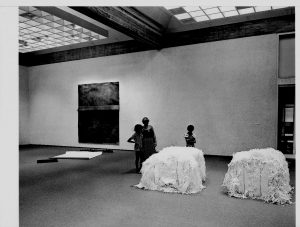
Joshua Neustein (American, born Poland, 1940)
Paper Bales, 1976
Paper bales
Installation view, Neustein, Tel Aviv Museum, 1977
© Joshua Neustein
Photo courtesy the artist
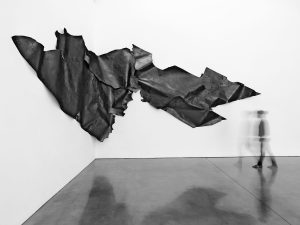
Nancy Rubins (American, born 1952)
Drawing, 2010
Graphite pencil on paper
134 x 379 x 12 in. (340 x 963 x 30 cm)
© Nancy Rubins
Photo: Erich Koyama, courtesy of Gagosian Gallery
About the Nasher Sculpture Center: Located in the heart of the Dallas Arts District, the Nasher Sculpture Center is home to the Raymond and Patsy Nasher Collection, one of the finest collections of modern and contemporary sculpture in the world, featuring more than 300 masterpieces by Calder, de Kooning, di Suvero, Giacometti, Gormley, Hepworth, Kelly, Matisse, Miró, Moore, Picasso, Rodin, Serra, and Shapiro, among others. On view in the light-filled galleries of the Renzo Piano-designed building and amid the garden grounds are a rotating selection of works from the Collection, as well as important exhibitions of modern and contemporary sculpture. Conceived for the exhibition, study, and conservation of modern and contemporary sculpture, the Nasher Sculpture Center also presents a diverse array of educational and cultural programs in dialogue with the Collection and special exhibitions. It is also the home of the Nasher Prize, an annual, international award that is presented to a living artist in recognition of a significant body of work that has had an extraordinary impact on the understanding of sculpture. In addition to the indoor and outdoor gallery spaces, the Center contains an auditorium, education and research facilities, a cafe, and a store.
Location: 2001 Flora Street, Dallas TX 75201
Hours: The Nasher Sculpture Center is open Tuesday through Sunday from 11 am to 5 pm and until 11 pm for special events, and from 10 am to 5 pm on the first Saturday of each month.
Admission: $10 for adults, $7 for seniors, $5 for students, and free for members, children 12 and under, and all members of police and fire departments with proper ID. Admission includes access to special exhibitions. For more information, visit www.NasherSculptureCenter.org.
